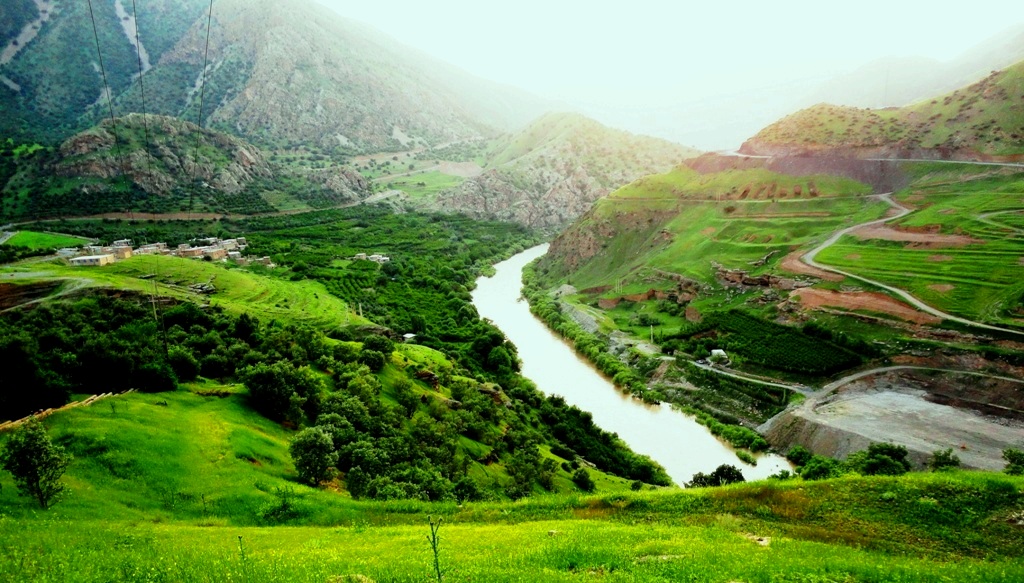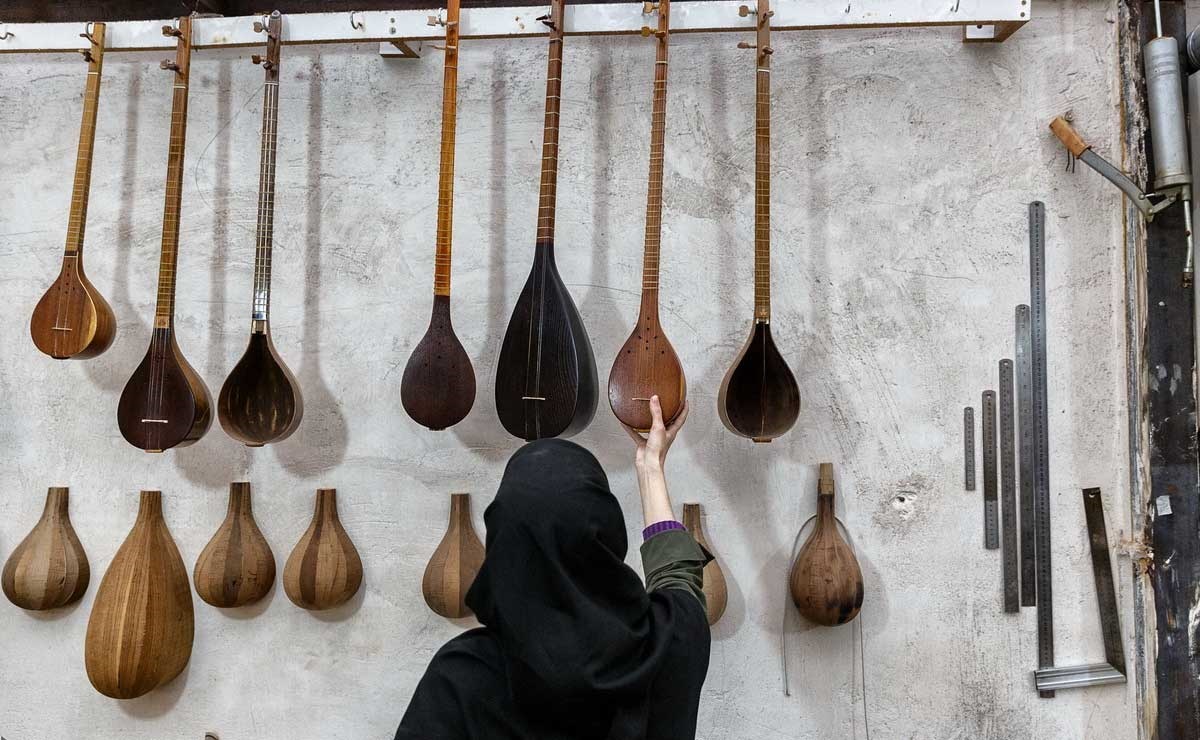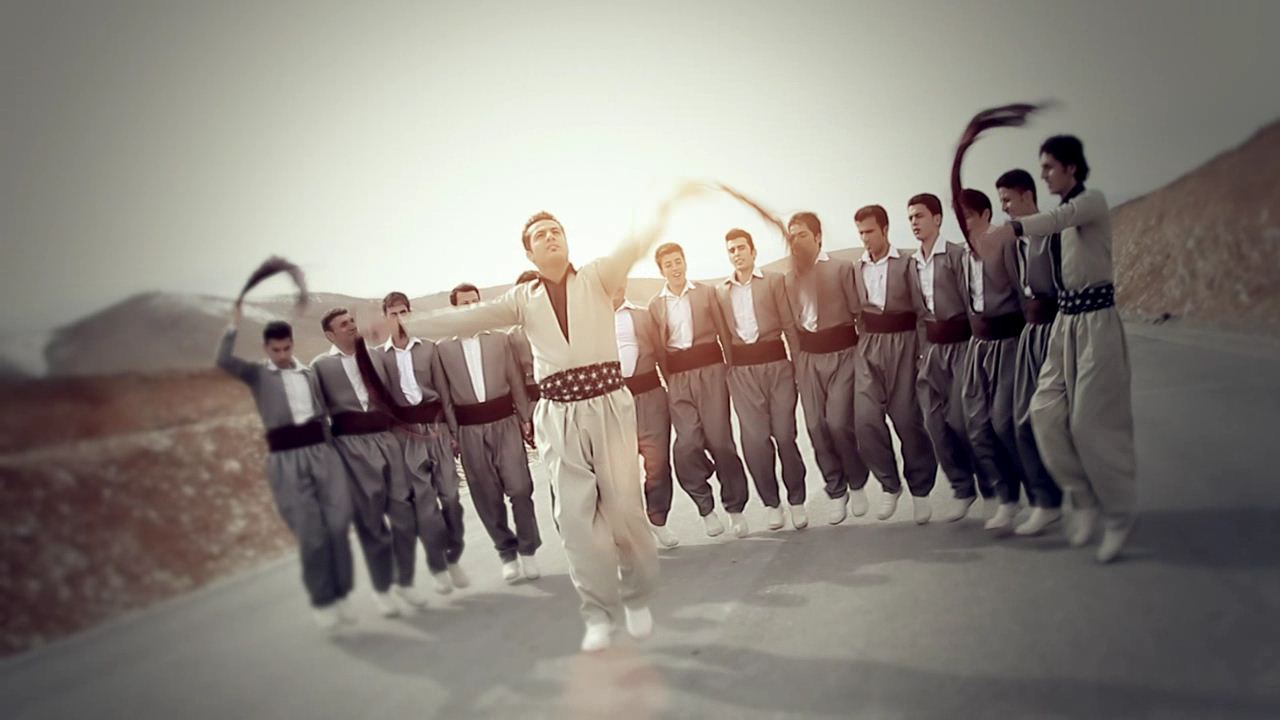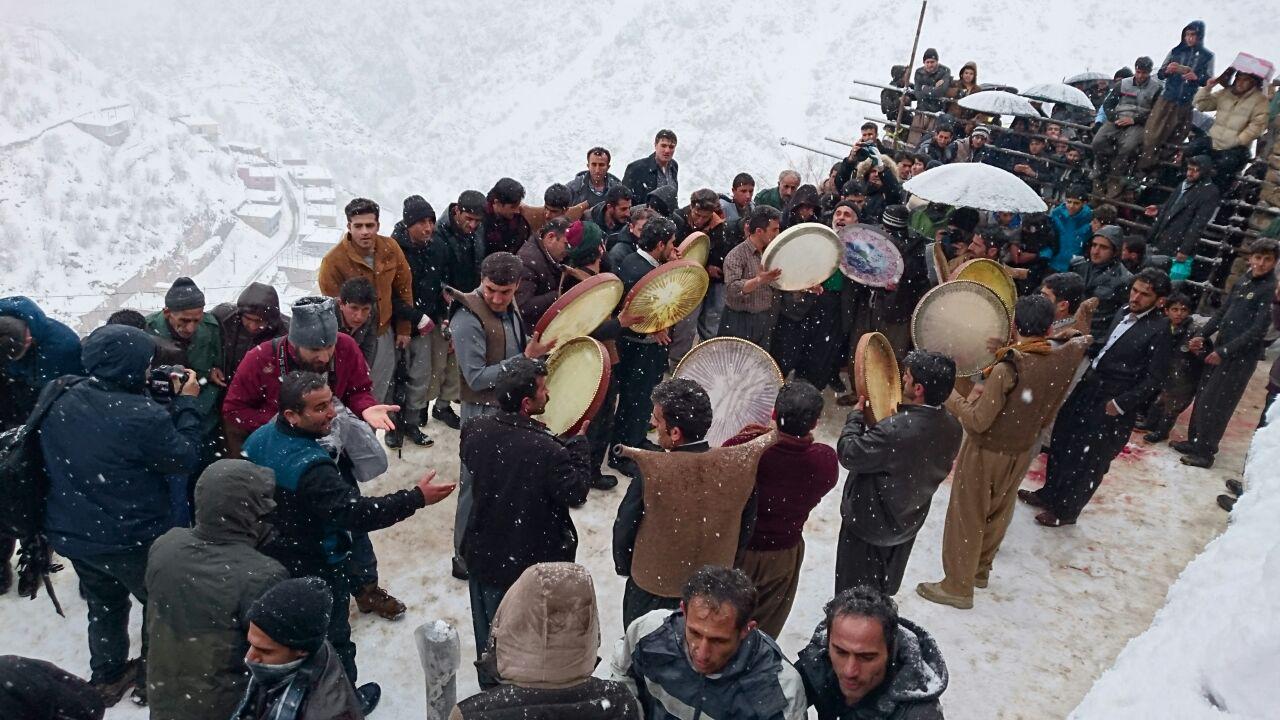Geography
Kurdistan Province located in the northwestern part of Iran covers a wide geographic area (28,203 kilometers) and has over 200 kms of shared border with Iraqi Kurdistan. Its neighbouring provinces are West Azarbaijan (north) and Zanjan (north and east), Hamedan (east), Kermanshah (south) Based on the last official state divisions in 2003, the province consists of 9 cities, 23 towns, 23 districts, 79 rural districts and 1,767 villages. The capital of the province is Sanandaj which is 512 kilometers from Tehran. The major cities of this province are Baneh, Bijar, Diwandareh , Saqiz, Qorveh, Kamyaran, Sarvabad and Mariwan (see map). As per the last population census in 2003, Kurdistan Province has 1,574,119 inhabitants and the most populated cities being, in the order mentioned, Sanandaj (419,750 people) and Saghez.
Natural and Climatic Conditions
Kurdistan Province is a mountainous region with an average altitude of 200 0 meters above sea level, making it the highest province in the country. It extends over high plains and within vast valleys of the region. The highest and the lowest points of the province are Mount Shaho and Aloot region with altitudes of 3300 and 900 meters , respectively making the height difference between the highest and the lowest points of the province 2,400 meters. This difference, in turn, creates different kinds of climates in the region with mild springs and summers and cold winters. Other significant mountain peaks of this province are Abidar, Soltan Serajeddin, Awalan (to the south of Sanandaj), Shahneshin (in Zhawarood), Kocheksar (to the south of Sanandaj), and Charkhalan (to the southwest of Sanandaj).

Altitude development direction and establishment is in such a way to make the first rains fall on the highlands of the area to the west of the country. Atmospheric fallout is in the form of snow at high altitudes and rain in the lower parts. The average annual rainfall in the province is 500 mm and the highest average annual rainfall occurs in the city of Marivan (800 mm). In addition, the province has many rivers, lakes, and natural ice-stores. The province's rivers normally join two river basins: the Caspian Sea basin and Lake Urmia Basin and some also enter Iraq. Ghazalavzan River and its tributaries of Qomchoqay, Avezandareh, Traval and Shoor flow into the Caspian Sea. Zarrinehroud River, Khorkhora River and Siminroud River and their tributaries join Lake Urmia basin. Sirvan River is the longest river with the largest watershed and number of tributaries in Kurdistan Province. It runs between deep valleys and has a high water flow rate making it ideal for canoeing and white water rafting. It eventually joins the Tigris River in Iraq.
Kurdistan Province has one natural lake (Zarivar Lake in Marivan) and many artificial lakes such as Gheshlagh (15 kilometers north of Gheshlagh Dam), Gawshan (45kms south of Sanandaj behind Gawshan Dam), and Bukan (north of city of Saghez). Lake Zarivar provides scenic views and lies at the feet high mountains. Its water is sparklingly fresh. The lake has an average depth of 3 metres but its maximum depth is of 50 metres. Its length is 5 km and has a maximum width of 1.7 km. This beautiful lake is surrounded by thick forests and provides ample opportunity for fishing and water-sports.

In addition to the many lakes and rivers, Kurdistan has the benefit of many resourceful mineral water springs. The most outstanding of these are: Govaz to the northwest of Kamyaran, Abetalkh close to Bijar and Baba Gargar to the north of Ghorveh.
Forests in the province cover an area of 320 hectares beginning in northern parts of Baneh and extending to Mariwan and western parts of Kurdistan Province. The forests are home to many varieties of trees including oak, oak apple, wild pear, ash and wild sour cherry tree. The forests provide refuge for many animals and birds such as leopard, ram, wild goat, hyena, jackal, wolf, fox, sable, weasel, partridge, wild duck, stork, parrot, and eagle.
Kurdistan Province also has many natural caves including Karafto Cave, close to Divandarreh. It is a not only a natural cave but also an archeological site as it was used by humans in prehistory. The cave has four floors with room entrances and windows. On one of the hall ceilings on the third floor, the name of the Greek god Hercules is carved and is therefore known as the Temple of Hercules. On the fourth floor of the cave, tiles and ancient artifacts have been discovered which testify to human habitation of the cave in the Parthian and Sassanid eras and until the Islamic period. Another prominent cave in the region is Shoovi Cave which is 267 metres long and lies near the city of Baneh.
The unique topography of this province, its beautiful nature and climatic variations have turned this area into an attractive spot for tourists. According to world standards, temperatures between 20 and 25 degrees of Celsius are highly favored by tourists; since the average daily temperature in this province from mid-May to mid-October ranges between 22 to 28 degrees Celsius, this period is the best time of the year for attracting summer tourists.
Industry
Most people in Kurdistan Province are engaged in agriculture and modern livestock farming. The natural climatic conditions of the region as well as its fertile lands make the province an ideal place for the aforementioned industry. Wheat, barley, grains and fruits are the major agricultural products. The chemical, metal, textile, leather and food industries are the other main industries in this province.
Handicrafts
Handicrafts of Kurdistan Province in western Iran reflect its people’s culture and were developed as per the needs of the people. The carpet-weaving and wood works of the Province have attracted world-wide attention and popularity. Kurdish carpets and rugs are famous due to their unique Kurdish designs, natural dyes and textiles used in their weaving. The cities of Bijar and Sanandaj are known for their high-quality carpets. A traditional weaving method known as Julai is used to make traditional Kurdish men’s clothing fabric by specialist weavers known as Julais. Other woven products include Mowj (which is used for wrapping mattresses, pillows and blankets) and Ja-Namaz (a type of prayer mat). Another example of handwoven product is Klash which is a type of footwear produced in Kurdish speaking areas and is highly suitable for mountainous regions due to the flexibility of its sole. The Klash’s light weight makes it a popular choice among Kurds even today in the dry seasons .

Kurdistan Province is renowned for the intricately designed chessboards and backgammon boards and has earned a reputation for handcrafting beautiful musical instruments, in large part due to the abundance of high quality wood in the region.

The province also boasts a wealth of musical talents which have lent credence to the area’s reputation. Kurdish musical instruments include the Qernête (a double reed musical instrument) and the tembûr (a fretted string instrument). Other wooden products produced in Kurdistan include pipes, hubble-bubbles, wooden chests and make-up boxes.

Other handicrafts which are produced in this province are stone products, basket weaving, jewelry and ornaments, and leather products.
The province boasts various local confectioneries such as Konjed Gazanbin, Badam-Sukhteh, Baslogh, and Nan-Berenji. From among these confectioneries Konjed is specifically made in the provincial capital Sanandaj and is highly favored by tourists.
Kurdish Culture and Language
One of the most important attractions of the province is its cultural features such as language, ethnic music, ethnic costume, ethnic dance, festivals, celebrations, and handicrafts. People in this province speak Kurdish as their first language. The Kurdish language is a west Iranian language related to Farsi and Pashto and like Farsi is a branch of the Indo-European languages. It has its own grammatical and writing regulations as a language. Due to the sporadic dispersion of Kurdish population and the vastness of Kurdistan ("Land of the Kurds"), this language has two main dialects and some sub dialects. The existence of various dialects has made this language very rich in terms of the number of vocabularies; and the melodic tone of its vocabularies has tremendously enriched the literary and musical practices.

Kurdish dance or Halparkeh mirrors the past history of Kurdish people and by taking a closer look at Kurdish dance, we would find out that this art is a complete reflection of people's daily life and work. The roots of this art could be traced back into the people's religious beliefs, national festivals and celebrations, local games of war and defense, and inner feelings and moods. Kurdish dance has so many varieties throughout Kurdistan, but Sanandaj and Mariwan are two famous and rich cities in this regard and the varieties danced are named as follows: Garyan, Peshtpa, Halgerten, Fatah Pashayee, Chopi, Zangi, Shlan, Sehjar, and Khanameeri. Traditional musical instruments are still used for dancing to but modern electrical musical instruments are in wider use.
Kurdistan boasts one of the most beautiful costumes in the world. As it is written by many tourists in their travel books, Kurdish costumes are absolutely unique in terms of beauty, delicacy and color. Due to their positive attributes they have won the first place in several international festivals. Traditional Kurdish clothes are still widely used in everyday life in many parts of the province and gain special significance at weddings and religious ceremonies.
Special Feasts and Festivals
One of the most popular public celebrations with Kurdish people is Nowrooz ( the beginning of a new year). Kurdish people celebrate Nowrooz by making fires and dancing round it in circles. Eid-e-Fetr and Eid-e-Qorban are two significant religious feasts which are dearly favored by Kurdish people as well the celebrations of the Prophet Mohammed’s (peace be upon him) birthday (Mawloodi) in the third month of the Islamic calendar.

Another important festival is the Pir-Shaliar Festival (an ancient traditional feast) which is held in the village of Uraman-Takht. Based on archaeological and historical records, settlements have exited in the Uraman region since prehistoric times. This famous festival is celebrated twice a year. It is held both on the 45th day of spring and 45th day of winter in the village of Pir-Shaliar. The ceremony celebrates the wedding anniversary of a legendary Pir (an elderly respectable person), whose name was Shahryar (or Shalyar in Kurdish dialects) with a princess, and it has its roots in the ancient myths of the area.

The Pir Shalyar ceremony begins by children distributing the walnuts of Pir Shalyar garden among the people of Uraman Takht and other villages in its vicinity. This is seen as an invitation to the villagers of the area to participate. It is usual for animals like cows, sheeps and goats to be sacrificed. Some special foods like a bread called Kolire Majgeh (dough made from flour, walnut, almond, and onion) is also baked and distributed amongst participants. The Daf musical instrument is played and zikr by dervishes take place while chanting special prayers. The number of attendees reaches thousands and thus can get very crowded. In recent years this festival has attracted national and even international attention.